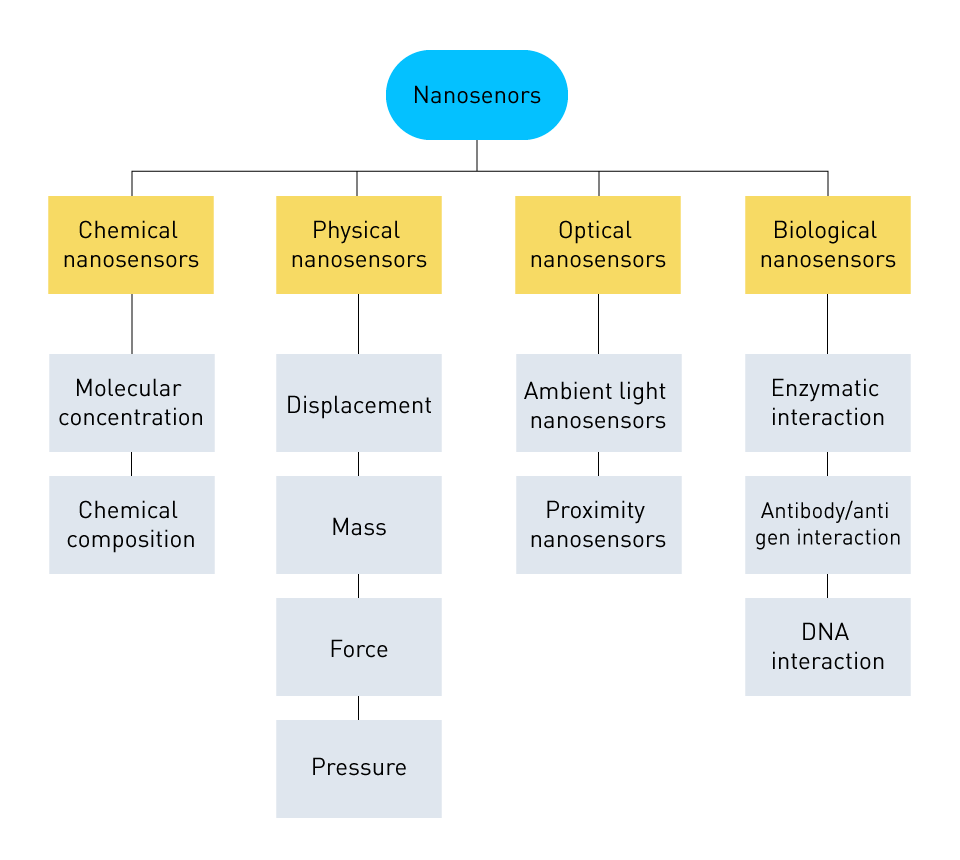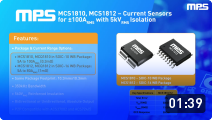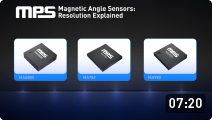Fundamentals of Nano-Sensing
To detect and analyze the existence, properties, concentration, or state of different substances, nano-sensing involves sensors at a nanometer scale. Due to its capability to explore phenomena at the nanoscale, this field has attracted colossal attention where properties can largely differ from those observed at larger scales.

Figure 1: Types of nanosensors
Unique Properties at the Nanoscale
Operating at the nanoscale, materials frequently showcase distinctive mechanical, electrical, and optical properties. This is primarily due to the prominence of quantum effects at such minuscule scales. Included in these unique properties are enhanced strength, modified electrical conductivity, and changed color—critical elements for the development of effective nano-sensors. As an example, the distinctive red color of gold nanoparticles arises from the oscillation of electrons, termed surface plasmon resonance—a phenomenon that occurs uniquely at the nanoscale.
Quantum Effects and Nano-Sensing: Playing a crucial role in nano-sensing, quantum effects frequently dictate the behavior of particles at the nanoscale. Fundamentally, quantum confinement, tunneling, and quantized energy levels bring about fundamental alterations in the interaction between nano-sensors and their environment. This enables the detection of changes in energy states, charge distribution, and bond formations with remarkable sensitivity and specificity. Highly effective in detecting minute concentrations of substances, nano-sensors leverage quantum effects to enable precise measurements and analyses at the molecular and atomic levels.
Sensing Mechanisms: At the nanoscale, sensing mechanisms typically entail the interaction between the sensor material and the target analyte. This interaction results in a measurable change, whether it be a a modification in electrical conductivity, shift in resonance frequency, or an alteration in optical properties. Transducing these alterations into legible signals allows for correlation with the concentration, presence, or state of the target substance.
Enhanced Surface-to-Volume Ratio: Enabling a larger interaction surface with the analyte, nano-sensors usually have a high surface-to-volume ratio, which increases the sensitivity and responsiveness of the sensor. Enabling the detection of exceedingly low concentrations of analytes, heightened surface interaction renders nano-sensors especially valuable in applications such as environmental monitoring, disease detection, and chemical analysis.
At the core of nano-sensing lies the exploitation of the distinctive properties that materials manifest at the nanoscale, heavily influenced by quantum effects. By adhering to these principles, nano-sensors engage with their surroundings in unique manners, delivering unmatched sensitivity and specificity in the detection and analysis of substances. Crucial for the development of advanced nano-sensors with diverse applications, ranging from healthcare diagnostics to environmental monitoring and industrial quality control, is a comprehensive understanding of these fundamental aspects.
Applications in Healthcare, Environment, and Industry
Revolutionizing various domains like healthcare, environmental science, and industrial processes, nano-sensor technology has ushered in groundbreaking advancements. In detecting minor traces of substances, the unparalleled sensitivity and specificity of nano-sensors are important, allowing early intervention and mitigation.
Healthcare: Disease Detection
Within the realm of healthcare, nano-sensors bear significant implications, particularly in the early diagnosis of diseases when intervention is most effective. An illustration of their capabilities lies in the identification of disease-specific biomarkers, such as those linked to cancer, at concentrations beyond the reach of conventional detection methods. Detecting molecular changes that signify pathological conditions in the early stages holds the potential to markedly enhance patient prognosis. This, in turn, facilitates personalized medical treatments, ultimately aiming to reduce mortality rates.
Environmental Science: Pollutant Monitoring
Nano-sensors are critical for monitoring pollutants and analyzing environmental conditions with high accuracy in environmental sciences. Detecting minuscule amounts of contaminants in air, water, and soil, these sensors enable the continuous monitoring of environmental pollution in real-time. Swift identification of hazardous substances allows for prompt remedial actions, contributing to the preservation of ecosystems and the safeguarding of public health. An example of their utility lies in the ability of nano-sensors to detect harmful chemicals or heavy metals in water sources, ensuring the safety and quality of water.
Industry: Quality Control
Playing a pivotal role in industrial applications, nano-sensors contribute significantly to both quality control and the optimization of processes. They are used to ensure product integrity, monitor material properties, and detect flaws. In manufacturing lines, nano-sensors, for instance, can identify microscopic defects in products. This enables swift corrective actions, ultimately minimizing the production of defective goods. Ensuring the manufacturing of top-notch products, this approach not only optimizes the utilization of resources but also minimizes waste. In doing so, it contributes to the adoption of sustainable manufacturing practices.
Synergy with Other Technologies
Amplifying their range of applications, the integration of nano-sensors with advanced data analytics and machine learning algorithms enhances their capabilities. Facilitating the creation of predictive models and intelligent systems, the integration enables autonomous decision-making. This process relies on the data obtained from nano-sensors, optimizing processes, and proactively addressing challenges across environmental monitoring, healthcare, and industrial applications.
Transformative in healthcare, environmental science, and industry, the integration of nano-sensor technology has ushered in unparalleled levels of sensitivity and precision. This extends to disease detection, pollutant monitoring, and quality control. Harnessing the distinctive properties of materials on the nanoscale, nano-sensors present promising solutions to the most urgent challenges in these domains. This paves the way for innovations that not only enhance human health but also safeguard the environment and optimize industrial processes.
Challenges in Fabrication and Deployment
Unlocking myriad possibilities across various fields, the implementation of nano-sensors is not without significant challenges in their fabrication and deployment. Particularly, issues related to scalability, stability, and sensitivity pose intricate hurdles.
Scalability, Stability, and Sensitivity Concerns
Scalability: Meeting the escalating demands for nano-sensors through large-scale production remains a daunting task. Sophisticated techniques and high precision are often necessary for fabricating sensors at the nanoscale, a process that is inherently resource-intensive due to its complexity. Due to the susceptibility of nanostructures to slight variations in the fabrication process, achieving uniformity and consistency in mass production poses a notable challenge. Crucial for the widespread availability and cost-effectiveness of nano-sensor technologies is the resolution of scalability issues.
Stability: In the deployment of nano-sensors, stability is another important challenge. Nano-sensors operate in an environment that can exhibit high variability, characterized by fluctuations in temperature, pressure, and exposure to various chemicals. Impactful on the structural integrity and functionality of nano-sensors, environmental factors necessitate the creation of designs and materials that are robust enough to withstand diverse operational conditions. Paramount for the reliable performance of nano-sensors over time is the assurance of long-term stability under real-world conditions.
Sensitivity: One of the standout features of nano-sensors is their heightened sensitivity; however, this characteristic also presents challenges. Nano-sensors, with their capability to detect exceedingly low concentrations of substances, become susceptible to interference and noise. This susceptibility can potentially result in false positives or negatives. Enhancing the selectivity and accuracy of nano-sensors requires the refinement of sensor designs and the integration of advanced signal processing techniques. This ensures the effective distinction of target substances from background components.
Interdisciplinary Solutions: Interdisciplinary efforts are essential for addressing these challenges, integrating advancements in materials science, engineering, chemistry, and data science. Overcoming barriers related to scalability, stability, and sensitivity requires innovative approaches in nanomaterial synthesis, the evolution of fabrication techniques, and the optimization of sensor designs. Furthermore, the merging of nano-sensor technology with computational methods has the potential to generate sophisticated models and algorithms. These, in turn, can enhance the reliability and efficacy of nano-sensors across various applications.
Navigating the path toward the practical implementation of nano-sensors involves combating substantial challenges in their fabrication and deployment. Essential to unleash the complete potential of nano-sensors and usher in the next wave of innovations in sensing technology is the overcoming of these challenges. Advancing nano-sensor technology to new frontiers and catalyzing its transformative impact across diverse domains becomes possible by tackling challenges related to scalability, stability, and sensitivity.
Case study: Using Nano-Sensors for Early Cancer Detection
Revolutionizing medical diagnostics, nano-sensors show great potential, especially in the early detection of cancer. Demonstrating the potential of nano-sensor integration, this case study highlights how medical practitioners can be empowered to detect cancerous cells and tissues in their early stages. This capability enables timely and more effective interventions.
Detection Mechanism: Nano-sensors prove invaluable in cancer detection due to their capacity to engage with biomolecules on the nanoscale. This interaction allows for the identification of irregularities in cellular mechanisms with unparalleled accuracy and sensitivity. Capable of identifying cancer markers like proteins or DNA mutations, these sensors can detect cancer at early stages, even in minimal concentrations, well before clinical symptoms manifest.
Application in Oncology: The significance of nano-sensors in oncology is their ability to identify elusive and aggressive cancer forms, frequently diagnosed too late for optimal treatment effectiveness. For example, incorporating nano-sensors into liquid biopsy methods facilitates the non-invasive examination of blood samples. This process enables the identification of circulating tumor DNA and tumor cells, providing indicators of malignancy presence in the body.
Advancements and Breakthroughs: The progress in nano-sensor technology has recently given rise to multifunctional nano-platforms. These platforms exhibit the capability to concurrently perform detection, imaging, and therapeutic functions. By adopting integrated strategies, one can not only achieve early cancer diagnosis but also engage in real-time monitoring of both therapeutic responses and the disease's progression. Moreover, when nano-sensors are combined with targeted drug delivery systems, it provides personalized and accurate medicine. This synergy aims to enhance therapeutic outcomes while reducing adverse effects.
Challenges and Outlook: Although the exciting potential of employing nano-sensors for early cancer detection exists, numerous challenges are also there. These challenges are majorly related to the reliability, specificity, and clinical validation of these technologies. To address these challenges and to convert nano-sensor innovations into routine clinical practices, the refinement of sensor designs, interdisciplinary research, and extensive clinical trials play a critical role.
Transformative Impact: Marking a paradigm shift in medical science, the integration of nano-sensors into cancer diagnostics opens path for proactive and preventive healthcare methodologies. Through facilitating the early identification of cancer, nano-sensors play a pivotal role in enhancing life quality, elevating survival rates, and lessening the socio-economic impact of the disease. In the relentless quest for progress in nano-sensor technology, there is an undeniable commitment to pushing the limits of medical science. This commitment holds the promise of giving hope and unlocking new possibilities in the ongoing battle against cancer.








直接登录
创建新帐号